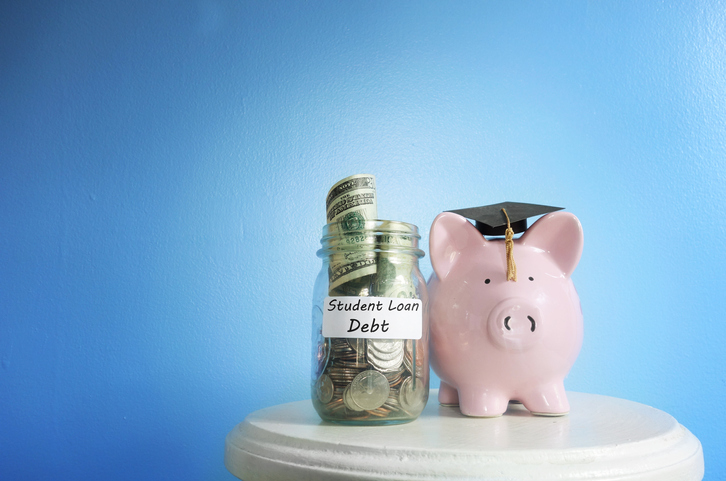It’s no secret that going to college comes with a hefty price tag, and if you, like every other college graduate, feel like you are drowning in debt — you’re not alone.
According to Forbes, the total student loan debt in 2020 was $1.56 trillion, the nation’s second-highest debt category behind the mortgage.
While you may be walking across the stage lugging a large debt behind you, we’re here to show you some strategies and resources available to help you manage debt in your post-college life.
Calculate Totals (Private and Federal) & Understand the Terms
First, you’ll need to understand where the loans came from. If you have personal and federal loans, you’ll want to review the total amounts you owe and the due date on all of them. By understanding your loan totals and terms, you can manage a repayment plan more effectively.
If you have a loan backed by the Department of Education (DOE), your lender will be one of several companies that the DOE contracts with to handle federal student loans. Remember that you do not choose your federal student loan servicer. If you are unaware of which company it is, you will need to look in the National Student Loan Data System (NSLDS), which will provide details about your federally-backed loan.
If you have student loans through your college or university, contact the financial aid office for details regarding your loan(s).
Another option is to obtain a copy of your credit report. Through consumer reporting agencies like Equifax or TransUnion, you can request one free copy of your credit report annually. The information will include details such as existing lenders, balances, and payment history.
Grace Periods
As you start to review the details of your loan(s), take note of the grace period. A grace period is the amount of time you have after graduation to start paying your loans back. Some lenders offer six-month grace periods, while others provide more or less, so be sure to check!
Grace periods allow graduates enough time to find a job, move, and handle other post-graduate expenses before the loan repayment process begins.
Strategy
While budgeting is not one-size-fits-all, there are some strategies you can use to prepare for your student loan repayment.
Once you understand the terms of your loan(s), you’ll want to start paying off the one with the highest interest rate first. Typically, the loans with the highest interest rates are from private lenders, not federally- backed loans — but it’s always a good idea to check. High interest rates can significantly impact the loan total if you let it sit too long, so understanding each loan’s APR will help you strategize more effectively.
Consolidation and Refinancing
Another option to consider is consolidation. This process allows you to combine multiple loans into one large loan. By consolidating your debts, the payoff period is typically extended, which means you’ll have more time to pay and fewer interest penalties over time.
If you wish to consolidate a federal loan, you will need to secure a direct consolidation loan from the DOE. In most cases, your interest rate won’t change as part of the process, but you should check with your lender before completing the consolidation.
Lastly, you can refinance your student loans through a private lender. Doing so allows you to get a lower interest rate than you’re currently paying which can add up to significant savings over time — meaning more money you can apply to your debt payoff each month — it’s a win-win.
Loan Forbearance and Deferment
If you find yourself in a position where you can’t make loan payments, there are multiple options available to help during tough financial times.
If you have federal student loans, you can temporarily postpone payments through an option called deferment. You may qualify for deferment if you are:
- A part-time student
- Currently within a lender’s grace period
- Unemployed
- Seeking an economic hardship
- In a qualifying internship, fellowship, or residency program
- An active-duty military service member
To learn more about deferment eligibility, review the requirements from the U.S. Department of Education’s office of Federal Student Aid.
If you don’t qualify for deferment, you also have an option for forbearance, which allows you to pause payments or make smaller payments temporarily. This program is available through federal and private lenders if you are willing but unable to make loan payments due to financial hardship. During forbearance, principal payments are postponed, but interest continues to accrue as normal. Be mindful of how many payments you pause or skip because the principal balance will increase the total amount you owe on the loan.
If forbearance doesn’t seem like the right fit for you, Federal Student Aid also offers other forms of relief, such as an income-driven repayment plan. With this program, if you are facing financial hardship for an extended period of time, you may qualify for lower monthly payments depending on your income and family size. According to Federal Student Aid, the four main types of income-driven repayment plans include:
- Revised Pay As You Earn Repayment Plan (REPAYE)
- Pay As You Earn Repayment Plan (PAYE)
- Income-Based Repayment Plan (IBR)
- Income-Contingent Repayment Plan (ICR)
If you’d like to learn more about repaying your student loans through an income-driven program, learn more here.
While your total debt amount may be overwhelming, you can rest easy knowing that there are solutions to help you in a time of need. Whether you’re unemployed, facing financial hardship, or in a transition period, federal and private lenders have resources available for you. Be proactive in managing your debt and find a solution that best fits your needs.





